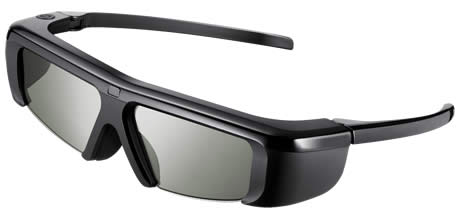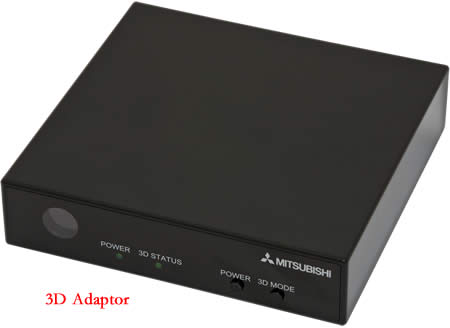 Last week we had an opportunity to speak to Frank DeMartin about the role Mitsubishi is playing in the 3D Entertainment Home market. Frank is responsible for all product development and marketing for the MDEA consumer electronics group in the U.S. DeMartin manages all CE product categories including home theater TV, premium flat panel TV, laser TV and digital home video. Most recently he has spearheaded the Mitsubishi Electric launch of the world’s first laser-based television, LaserVue, and he has led the development and introduction of the world’s only immersive sound television, Mitsubishi Unisen TV.
Last week we had an opportunity to speak to Frank DeMartin about the role Mitsubishi is playing in the 3D Entertainment Home market. Frank is responsible for all product development and marketing for the MDEA consumer electronics group in the U.S. DeMartin manages all CE product categories including home theater TV, premium flat panel TV, laser TV and digital home video. Most recently he has spearheaded the Mitsubishi Electric launch of the world’s first laser-based television, LaserVue, and he has led the development and introduction of the world’s only immersive sound television, Mitsubishi Unisen TV.
Before joining Mitsubishi Electric, DeMartin was director of sales and marketing, for Sharp Electronics’ Consumer Electronics Group. While at Sharp, he was responsible for the development and launch of AQUOS LCD TV as well as the company’s first HDTVs and other consumer electronics products. Previously, DeMartin was director of interactive technology for Sony Electronics, where his responsibilities included R&D, strategic planning and business development. DeMartin holds an MBA from the Kenan-Flagler Business School at the University of North Carolina, and a BS in Electrical Engineering from Rensselaer Polytechnic Institute.
Bijan Tehrani: Mitsubishi has been a player in the 3-D market for a long time, so can you tell us a little bit about the background of the Mitsubishi 3-D technology?
Frank DeMartin: Mitsubishi has long been a provider of DLP; back in 2004 was when we first released our consumer DLP displays. DLP technology is well suited for 3-D and we worked very closely with Texas Instruments that is the inventor of DLP and we realized that DLP was capable of 3_D and we started developing DLP technology with TI. We thought that that was an advantage of the technology that we needed to leverage. The good thing about 3D on a DLP display is that it does not really cost a lot, so we felt that that really gave us an advantage in the market so we were able to release our 3-D technology fairly early in 2007. We worked with companies such as NVIDIA, that is heavily into 3D PC gaming market and began to develop a market for 3D displays.
BT: Is it true that DLP technology offers the best 3-D image?
FD: Yes we believe that DLP offers a truly immersive 3-D picture, and our laser-based DLP 75″ display that we call LaserVue offers our best 3D picture available today. DLP has several advantages that are  important for 3D, in 3D displays goes through a lot switching between the right image and the left image and DLP switches so fast from right image to the left image that the separation between right eye and left eye images are maintained. Other technologies cannot do that, actually DLP is up to a 1000x’s faster than the other 3-D technologies on the market especially when it comes to the capability of image switching in terms of the left and right eye; they switch in milliseconds, while DLP is switching in Microseconds.
important for 3D, in 3D displays goes through a lot switching between the right image and the left image and DLP switches so fast from right image to the left image that the separation between right eye and left eye images are maintained. Other technologies cannot do that, actually DLP is up to a 1000x’s faster than the other 3-D technologies on the market especially when it comes to the capability of image switching in terms of the left and right eye; they switch in milliseconds, while DLP is switching in Microseconds.
BT: What are some of the recent 3-D ready TV’s by Mitsubishi?
FD: This year we have introduced a full line of what we call 3-D DLP Home Cinema TVs. It is a notion of bringing 3D cinema experience home. As you know DLP is used in more than 90% of U.S. theatres today so we already have an advantage over other technologies. We offer five 3D screen sizes including 60”, 65″, 73”, 75” and our mammoth 82″. We currently have fourteen models of 3D DLP products which is among the most of any manufacturer of 3-D TV’s this year.
BT: What advantages do these Mitsubishi 3D ready TVs have over the older Mitsubishi3-D TV models? In older models that we tries you had to rename the HDMI input used for 3D signal into Game or PC in order to activate the 3D, also the only kind of 3D signal accepted was the Checkerboard, are newer model any different?
FD: The UI has been made simpler so that when you connect to a 3-D source in conjunction with our 3D adapter the DLP TV will automatically switch to the 3D mode. Our 6 series are 3D ready, Our 7 and 8 series are 3-D upgradable through a software upgrade which will be made available late summer 2010 which will enable the 7 and 8 series models to accept many different 3D signals, including the mandatory HDMI 1.4a 3D formats.
 BT: Can you explain what the new adapter/converter kit is used for?
BT: Can you explain what the new adapter/converter kit is used for?
FD: We offer two 3-D accessory products; we offer our 3-D A 1 which is merely an adapter, so it will convert all the 3-D formats into checkerboard that is accepted by our older Mitsubishi 3D ready TVs such as those Mitsubishi owners who have the 3-D ready TV’s from 2007, they know have the ability to use the 3-D upgrade. The other product is our 3-D starter pack which is the 3DC1000. That pack includes the adapter; an Emitter, and also two pairs of active 3-D glasses as well as a Disney 3-D showcase disc which shows some great 3-D samples from Disney. So we think that these two products add a great deal of value to the market and we fully expect to have at least 20% of the market share in 3-D TV’s.
BT: Compatibility issues in 3D home entertainment field are really confusing consumers, certain 3D ready TVs or 3D ready Blue-ray players, work only with certain 3D glasses. What has Mitsubishi has done to help solve this problem and do you think that in the future there will be a universal 3D standard?
FD: With any new technology in the beginning there are often issues that go along with the adaption of that new technology, and with 3-D the issue of eyewear compatibility is an issue that needs to progress to make the 3D a very robust market. I think we are headed towards that direction. Mitsubishi 3D that we provide in our starter pack comes with an emitter so basically our glasses can be used with any TV which uses an emitter and has a plug for an emitter. Additionally our glasses are compatible with currently available Samsung 3DTVs. Also universal 3D eyewear offered by companies such as XpanD are great solution and we are active in the Consumer Electronics Association, that I am a member of the Video Board, there are several groups that are working on standards and one of those groups is working on a 3D eyewear standard.
BT: Right now there are two products that we are aware of that output checkerboard signal, one is Aspen Media Products, Aspen Media Player and the other on is Panasonic DMP-BDT 350 3D Ready Blue-ray player, do you know of any other product that directly outputs the right 3D signal for the older models of Mitsubishi 3D ready TVs?
FD: Any nVidia capable PC should be able output checkerboard. We are very pleased with both Aspen Media Player and the Panasonic DMP-BDT 350 offering checkerboard output. those  blue ray players are also offering the option of checkerboard. Interesting enough the game consuls, whether it is a XBOX or PS3, is capable of sending checkerboard output if their developer chooses to do so. AVATAR The Game is great example of a 3D game title that could be played on our displays using a XBOX or PS3 with a checkerboard output.
blue ray players are also offering the option of checkerboard. Interesting enough the game consuls, whether it is a XBOX or PS3, is capable of sending checkerboard output if their developer chooses to do so. AVATAR The Game is great example of a 3D game title that could be played on our displays using a XBOX or PS3 with a checkerboard output.
BT: One of the concerns of consumers is that there is not enough 3- D content on the market to invest in a home 3-D system. How do you see the pace of growth of 3D content?
FM: It’s really interesting, I am amazed at the amount of 3-D content that is available and is becoming available. A few years ago there was hardly anything available in HD for almost 2 years and now you see how much content in available in HD. Now we are at the beginning of the emerge of 3D home entertainment and the 3-D is available in the cinema we see that films are a great source of 3-D content that move into 3D Blue-ray discs. Hollywood is pushing the 3D contents for both theaters and home market. Broadcast also has started to go to 3-D as well, when you look at the World Cup in 3D and the 3D All Star game, there is a very long list of 3-D sports that will become available and soon US Open will be broadcasted in 3D. I am very pleased and excite about all of the content that will become available in the coming years.

